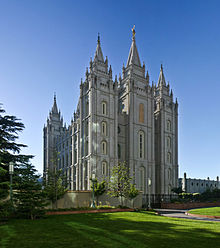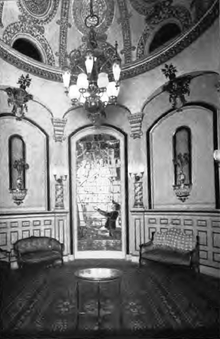Holy of Holies (LDS Church)



The Holy of Holies or Holiest of Holies is a room in the
Location and description
The Holy of Holies is a room adjoining the
Teachings by LDS Church leaders
Boyd K. Packer, who was a member of the Quorum of the Twelve Apostles, has stated that "hidden away in the central part of the temple is the Holy of Holies, where the President of the Church may retire when burdened down with heavy decisions to seek an interview with Him whose Church it is. The prophet holds the keys, the spiritual keys and the very literal key to this one door in that sacred edifice".[5]
Apostle James E. Talmage stated that "this room is reserved for the higher ordinances in the Priesthood relating to the exaltation of both living and dead".[6]
Joseph Smith, the founder of the Latter Day Saint movement, stated that "no one can truly say he knows God until he has handled something, and this can only be done in the Holiest of Holies".[7]
Cognate of the "most holy place"
Although not a general rule, in certain contexts outside of the LDS Church the term "Holy of Holies" may be synonymous with the "most holy place" referred to in the Book of Exodus. The construction "Holy of Holies" is a translation of a
In church scriptures
Speaking of the purposes of temples
"Therefore, verily I say unto you, that your anointings, and your washings, and your baptisms for the dead, and your solemn assemblies, and your memorials for your sacrifices by the sons of Levi, and for your oracles in your most holy places wherein you receive conversations, and your statutes and judgments, for the beginning of the revelations and foundation of Zion, and for the glory, honor, and endowment of all her municipals, are ordained by the ordinance of my holy house, which my people are always commanded to build unto my holy name."[8]
First Presidency receives the oracles for the church
"I give unto [Joseph Smith] for counselors my servant Sidney Rigdon and my servant William Law, that these may constitute a quorum and First Presidency, to receive the oracles for the whole church".[9]
See also
- Adam-ondi-Ahman
- Kadosh Kadoshim
- Sacred Grove (Latter Day Saint movement)
- Sanctum sanctorum
- Second anointing
References
- ^ Buerger, David John (November 2002). The Mysteries of Godliness. Signature Books. Archived from the original on 23 March 2006. Retrieved 8 June 2022. (excerpts only online)
- ^ Buerger, David John (1983). "'The Fulness of the Priesthood': The Second Anointing in Latter-day Saint Theology and Practice" (PDF). Dialogue: A Journal of Mormon Thought. 16 (1): 43.
- OCLC 24502140
- ^ Joyce Athay Janetski, "Louis Comfort Tiffany: Stained Glass in Utah", Utah Preservation/Restoration: A Publication for the Preservationist, vol. 3 (1981), pp. 20–25.
- Joyce Athay Janetski, "Stained Glass Windows: A Latter-day Saint Legacy", Ensign, January 1981, pp. 34–41. - ^ Boyd K. Packer (1980). The Holy Temple (Salt Lake City, Utah: Bookcraft) p. 4.
- ^ James E. Talmage (1969). The House of the Lord (Salt Lake City, Utah: Bookcraft) pp. 192–94.
- ^ Joseph Smith "Discourse, 1 May 1842, as Reported by Willard Richards", p. 94, The Joseph Smith Papers, accessed November 27, 2020
- ^ Doctrine & Covenants 124:39 (emphasis added).
- ^ Doctrine & Covenants 124:126 (emphasis added).
External links
- Liu, Yvonne. (July 14, 2018). "What the Church Has Said About the Holy of Holies". LDS Living. Retrieved 2020-08-29.
